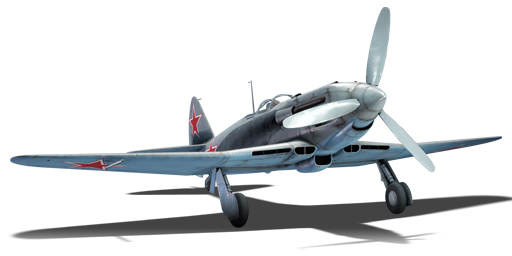



The I-225 was a proposed Soviet high altitude interceptor. It marked the conclusion of the I-220 series which was originally derived from the MiG-3. Compared to its predecessors, the I-225 was both the heaviest and the most powerful. Additionally, it had a significantly improved Shchyerbakov pressure cabin, 8mm seat armour, and an arsenal of four synchronized 20mm ShVAK cannons. The I-225 was designed to have a top speed of more than 700 km/h and a service ceiling of 12,000 meters, which made it capable of intercepting enemy aircraft at high altitudes. The second prototype, which is the one we have in the game, became the second fastest Soviet piston-engined fighter, only being surpassed by the Yak-3M. Despite its promising performance, the I-225 faced too many delays as most of the work was focused on the I-250, and in the end, it ended up being overshadowed by other aircraft designs.
The I-225 was introduced in Update 1.81 "The Valkyries". It is one of the last piston fighters in the Soviet avation tree and is one of the best prop fighters the Soviet Union has to offer. It is best used at high altitudes, where its performance really shines and where it can outperform most of its contemporaries. But it's not a bad idea to only climb as much as you need to, because trying to dive straight on at enemies at lower altitudes can put the I-225 at a disadvantage due to its high-speed compression.
flaps
flaps
flaps
brake
| Belt | Belt filling | Armor penetration (mm) at a distance: | |||||
|---|---|---|---|---|---|---|---|
| 10 m | 100 m | 500 m | 1000 m | 1500 m | 2000 m | ||
| FI-T/AP-I | 28 | 24 | 14 | 7 | 4 | 2 | |
| FI-T/HEF/AP-I/FI-T | 28 | 24 | 14 | 7 | 4 | 2 | |
| HEF/FI-T/AP-I | 28 | 24 | 14 | 7 | 4 | 2 | |
| FI-T | 4 | 4 | 4 | 4 | 4 | 4 | |
| AP-I/FI-T/AP-I/AP-I | 28 | 24 | 14 | 7 | 4 | 2 | |
| AP-I/HEF/HEF/FI | 28 | 24 | 14 | 7 | 4 | 2 | |












Flight performance | |
|---|---|
Survivability |
|---|
Weaponry |
|---|